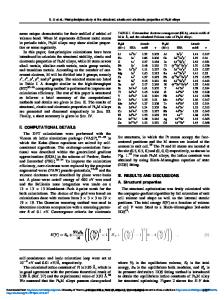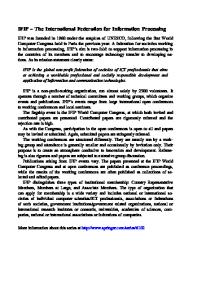High-Pressure Properties of Na 3 ClO Anti-perovskite from First Principles: an exploratory study
- PDF / 373,191 Bytes
- 6 Pages / 414.72 x 648 pts Page_size
- 70 Downloads / 322 Views
ABSTRACT We present the results of an exploratory theoretical study of Na3 ClO in the anti-perovskite structure. The FLAPW method is used to calculate the static lattice properties, pressure equation of state, and the ferroic Fl, phonon frequencies in the cubic Pm3m phase. We also compute the compression behavior of NaCI and Na2 O and find that the lattice energy of Na3CIO at ambient pressure (static lattice) is only marginally larger than of products, in agreement with experiment. However, detailed calculations reveal M- and R-point phonon instabilities in the ideal cubic phase and suggest the existence of lower symmetry structure involving slight rotations of ONa6 octahedra.
INTRODUCTION A prototypical structural motif exhibited by materials possessing the ABX 3 formula unit is the perovskite structure consisting of corner-shared BX6 octahedra on a cubic lattice with the A ion occupying the central cage site. Within this class of compounds the oxides have been most
exhaustively explored because of their technological and geological importance. In the latter, the A-atom is typically a second row element, while the B-atom is either a transition metal (e.g., SrTiO3 , BaTi0 3) or a group IV element (e.g., MgSiO3, CaSiO3, SrGe0 3). While the high symmetry cubic perovskite (Pm3m) structure is rarely exhibited by these compounds under normal pressure and temperature conditions it does represent a useful starting point for understanding the vibrational, structural and chemical trends observed. For example, by studying the nature of the structural (mechanical) instabilities in the cubic perovskite phase the tendency of a compound to form various possible lower symmetry phases can be determined. Structural destabilization of the cubic perovskite structure typically involves one or more of the following mechanisms: (i) rotations of the octahedral cages, (ii) off-center displacement of the B-ions within the octahedral cages, and (iii) longitudinal distortions of the octahedral cages themselves. While some of these can be interpreted in terms of soft phonon modes, others involve more subtle electronic effects. Significant effort has been expended in the search for novel materials within this composition class. With the recent advent of high-efficiency first principles computational methods, modeling has taken on a complementary role to experiment resulting in a flurry of activity in the area of exploratory simulation. Quantitative estimates of the equation of state, vibrational and electronic structure and optical properties of complex compounds can now routinely be obtained at a modest computational expense. 167 Mat. Res. Soc. Symp. Proc. Vol. 499 01998 Materials Research Society
Our own recent success in modeling the properties of a number of oxide perovskites[1,2] provides the main motivation for the present study, which focuses on the anti-perovskite phase of Na3ClO. This compound was recently synthesized in both powder and single crystal form and a subsequent x-ray structure refinement suggested a simple cubic perovs
Data Loading...










